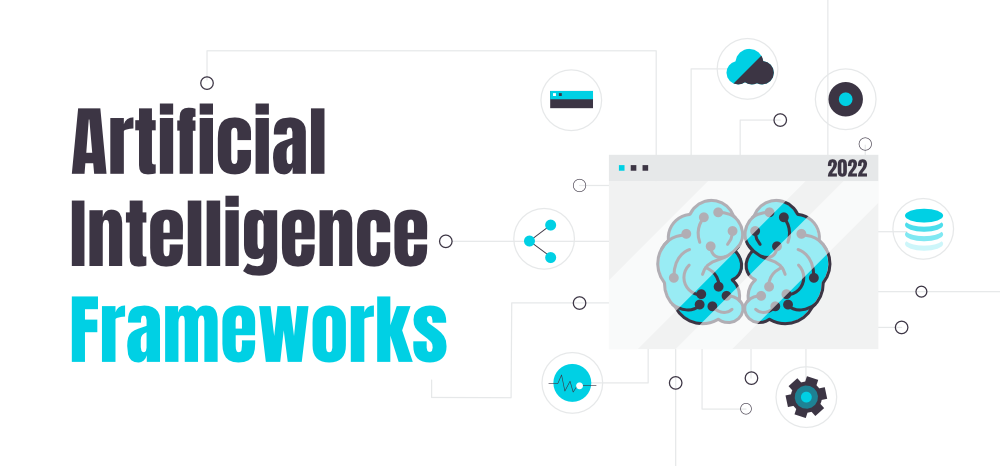Artificial Intelligence (AI) plays a crucial role in today’s digital world, and it’s expected to reach a market value of $190.61 billion by 2025. People from all walks of life, including digital enthusiasts and the average person, are contributing to this transformation.
Easy-to-use tools like Python, AI models, and the best AI frameworks make it accessible for more people to join in, creating a collaborative effort to shape the global digital landscape. As per the survey, the global AI market is expected to reach $190.61 billion by the year 2025.
Top artificial intelligence frameworks speed up the creation of AI applications, covering various areas like deep learning, machine learning, NLP solutions, and neural networks. As AI becomes more common, dealing with large sets of data, known as “big data,” becomes a challenge for organizations. This is why many technologies today require a reliable artificial intelligence framework to effectively handle and make sense of such data.
Top 10 AI Frameworks for 2024
Here are the top 10 Artificial Intelligence Framework to Explore in 2024:
1. TensorFlow
Minimal research on AI frameworks is almost assured to lead you to TensorFlow. It is an open source platform which was developed by the team of Google Brain for internal Google use in production and research. The primary version was released in 2015 under the Apache License 2.0. It can be used within an array of programming languages, particularly Python, JavaScript, C++, and Java as well.
Key Features:
- Google released an updated version – Tensor 2.15.0, in November, 2023.
- Computational Power: Can be used on any CPU or GPU and therefore has high computational power.
- Usage of Graph Abstraction: Uses graph abstraction for creating machine models. TensorFlow permits the building of neural networks with graphs that depict operations as nodes.
To get more information about TensorFlow click here.
2. PyTorch
PyTorch is one of the most opted open source frameworks as it is super-adaptable in terms of integrations and languages. It was developed by Facebook’s AI Research lab and was released in January 2016 as an open-source library chiefly used in deep learning, computer vision, and natural language processing software. Another notable feature of Pytorch is its great affinity with iOS as well as Android.
Key Features:
- Updated version: Pytorch 2.1.2 15 December 2023;
- Computational Graph: During runtime, it has computational graph support. Therefore expressing and evaluating a mathematical expression is easier in PyTorch.
- Easy Debugging: It uses debugging tools like IPDB and PDB. Programmers can use Python’s IDE PyCharm for debugging due to the computational graph at runtime.
3. Theano
Theano is a python based AI framework capable of delivering peak precision for networks that need high computational power. The initial release of this framework was made on 2007. It is used for manipulating and evaluating mathematical expressions, typically matrix-valued expressions. Expressions in Theano are evaluated faster because of dynamic code generation. It also supports high-level modules like Lasagne.
Key Features:
- Updated version: Theano 1.0.5 on 27th of July 2020
- Execution Speed: It can use GPUs and execute fragments of expressions in GPU or CPU, which is faster than Python.
- Impeccable Accuracy Ratio: It is known for its accuracy and provides a great accuracy ratio regardless of how minimal the values are, which makes it highly preferable.
To know more about this amazing AI framework click here.
4. Microsoft CNTK
Microsoft Cognitive Toolkit is a versatile framework supporting voice remodeling, message, and text. The initial release of this framework was made on 25 Jan 2016. This framework provides an efficient expression of low leveled and high leveled networks and its resources assure high efficiency due to optimum utilization. Microsoft CNTK is Python and C++ compatible and hence can work with various servers at a time, shortening the span of the entire process.
Key Features:
- Updated version: Microsoft CNTK 2.7 26 April 2019.
- Highly advanced: It’s highly advanced as it supports GAN, CNN, and RNN. Also, CNTK is highly optimized to provide accuracy, scalability, and high-level integration.
- Faster Evaluation: It offers a faster evaluation of machine models that provides a scalable environment.
5. Scikit-learn
Scikit-learn offers an array of supervised and unsupervised algorithms and is based on Python. Through SciKit, the veracity of supervised models on unseen data can be checked. Also, particular features from images and text can be extracted using this framework.
Key Features:
- Latest version: scikit-learn 1.3.2. in October 2023
- Dimensionality Moderation: Reduction of attributes in data for feature selection and summarizing.
- Supervised Learning Algorithms: Has a plethora of supervised learning algorithms like Support Vector Machines and Decision Trees.
- Unsupervised Learning Algorithms: Also has unsupervised algorithms like cluster analysis, factoring, and unsupervised neural networks.
6. Apache Mahout
Apache Mahout aims at the development of scalable frameworks and is one of the most preferred open-source networks. It allows applications to analyze large data volumes in a relatively short period. It also enables evolutionary programming as Mahout comes with distributed function capabilities. It is developed in Java and Scala.
Key Features:
- Latest version: Apache Mahout latest version is 14.1. in October 2019.
- Ready-to-use framework: Mahout is very favorable for developers in terms of conducting data mining on sizable sets of data, due to its ready-to-use framework.
- Mathematically Expressive: It uses Scala DSL that is mathematically very expressive. Hence the width of ideas that can be portrayed in that specific language is more.
7. Amazon Machine Learning
Amazon Machine Learning is a new player in the AI sphere but is quickly becoming famous due to its apt features. It was initially released on 29 November 2017. The fundamental operations of this framework consist of data analysis, model training, and evaluation. Amazon Machine Learning is very beginner-friendly as it has customized tools for every experience level. Hence it’s a preferable option for developers of all skill levels.
Key features:
- Latest version: Amazon Machine Learning latest version is 14.1. in October 2019.
- Wide Usage: This framework is widely used by developers, data scientists, and machine learning researchers as it allows to discover patterns in end-user data through algorithms and construct mathematical models based on these patterns.
- Abstracted Framework: Amazon Machine Learning provides less versatility due to its abstracted framework.
- AI-powered framework: This framework has less code due to its AI-powered framework and APIs. It permits business analysts to develop ML models and forecast accurate predictions without much ML expertise.
8. PaddlePaddle
PaddlePaddle, also known as Paddle, is a rising AI framework made by Baidu. It’s gaining popularity for being versatile and having many useful tools, making it suitable for both research and practical applications. PaddlePaddle comes with a variety of pre-made models and tools for tasks like understanding language and processing images.
Key Features:
- Latest version: paddlepaddle(2.6.0) released in Sep 27, 2020.
- User-Friendly: Its user-friendly features make it accessible to developers, irrespective of their experience level.
- End-to-End Development Support: PaddlePaddle supports end-to-end development, streamlining the process of creating complete AI applications.
- Growing Ecosystem: While its community is still expanding, PaddlePaddle’s appeal lies in its continuous growth and development.
9. Jax
Jax is a new framework getting attention for being flexible and great for high-performance number work. Created by Google Research, it’s especially good for scientific tasks, machine learning research, and trying out neural networks. Though it takes a bit to learn, people like Jax because it can be both flexible and fast. It works well with Python, which makes it a good choice for developers who know Python.
Key Features:
- Latest version: Jax 0.4. 17 released on October 3, 2023.
- Flexibility and Performance: Jax, from Google Research, is gaining attention for its flexibility and robust support for high-performance numerical computing.
- Scientific Computing Focus: Well-suited for scientific computing, machine learning research, and experimenting with neural networks.
- Moderate Learning Curve: Although it may take some time to learn, Jax is becoming more popular due to its unique ability to balance flexibility and performance.
10. Caffe
‘Caffe‘ is a deep learning framework designed with a focus on clarity, speed, and scalability. It’s developed by the Berkeley Vision and Learning Center (BVLC) with contributions from the community. Google’s DeepDream uses the Caffe Framework.
Key features:
- Latest version: Caffe 1.0. in 2017.
- Core Architecture: Caffe’s core is written in C++, and it provides a Python interface, creating a flexible and adaptable structure for deep learning applications.
- Speed: Notably, Caffe is recognized for its high speed, especially when handling image processing on Graphics Processing Units (GPUs).
- Versatile Applications: Well-suited for both industrial deployment and research experiments, Caffe supports various types of deep learning architectures, making it versatile for tasks like image classification and segmentation.
Conclusion
In the rapidly evolving landscape of AI frameworks, 2024 witnesses a surge in accessible tools, best AI frameworks, and AI models, emphasizing Python’s pivotal role. From TensorFlow’s computational might to the versatility of PaddlePaddle and the flexibility of Jax, developers are empowered with opensource solutions.
The global AI market’s projected growth to $190.61 billion by 2025 underscores the transformative influence of these AI frameworks, propelling the digital landscape toward a future shaped by innovation and collective effort.
Top Artificial Intelligence Frameworks in 2024 – FAQs
What is an AI framework?
An AI framework is a software collection containing libraries, tools, and pre-built functions designed to simplify building and deploying AI models. It streamlines the development process by offering:
- Standardized development environment: A consistent structure for your AI projects.
- Pre-built components: Ready-to-use building blocks for common AI tasks.
- Performance optimization: Efficient tools for model training and deployment.
- Hardware compatibility: Support for various computing platforms.
- Collaboration tools: Facilitates team work and knowledge sharing.
Which Python framework is used for AI?
There are several Python frameworks are used to cater different AI tasks such as:
- TensorFlow: Popular for production-ready deep learning models, offering scalability and flexibility.
- PyTorch: Dynamic and research-friendly, emphasizing ease of use and debugging.
- Keras: High-level API for building deep learning models on top of TensorFlow or other frameworks.
- Scikit-learn: For general machine learning tasks like classification, regression, and clustering.
- SpaCy: Powerful framework for natural language processing.
Which framework does OpenAI use?
OpenAI primarily uses its own custom frameworks built on top of TensorFlow and other libraries. While they aren’t publicly available, OpenAI provides various services and tools built on these frameworks, like OpenAI Gym (reinforcement learning) and ChatGPT (natural language processing).
Which model is best for AI?
There’s no single “best” model for AI, as it depends on the specific problem you’re trying to solve. Different models excel in different tasks, with some popular examples being:
- Image recognition: Convolutional neural networks (CNNs) like VGG16 and ResNet.
- Natural language processing: Transformers like BERT and GPT-3.
- Speech recognition: Deep learning models like Kaldi and Wav2Vec.
- Recommender systems: Matrix factorization models like Collaborative Filtering.
What are the AI trends in 2024?
Increased automation, improved explainability tools, better hardware integration, focus on low-power devices, and development of secure and robust AI systems.
What are the trends for artificial intelligence in 2025?
Continued growth in AI-driven automation, improved AI-aided decision-making, and widespread adoption of AI in healthcare and climate-related solutions.
What AI can do in 2030?
Predictions include AI-driven personalized healthcare, advanced autonomous systems, and AI contributing significantly to climate change mitigation and sustainability efforts.





